
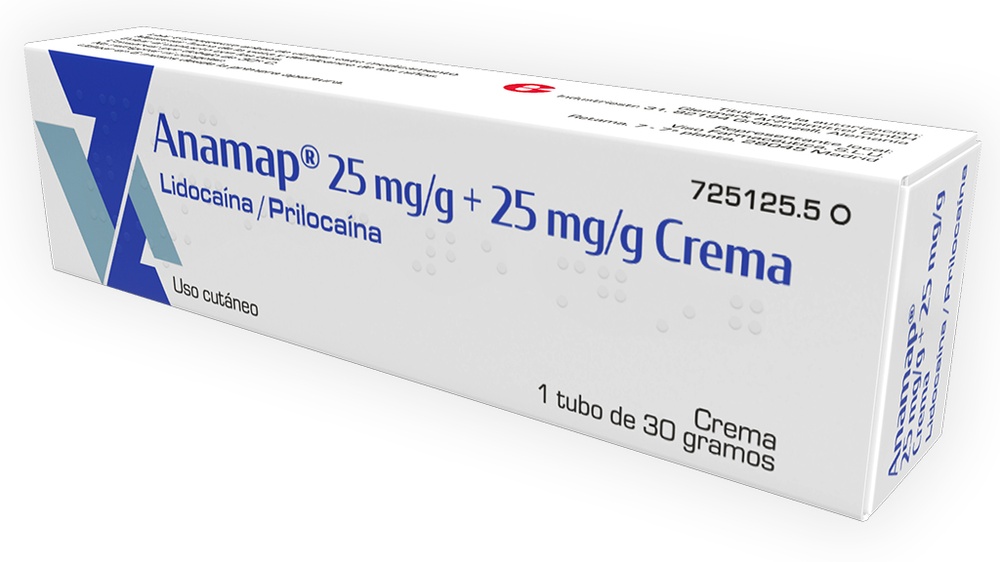
ANAMAP 25 mg/g + 25 mg/g CREME

Pergunte a um médico sobre a prescrição de ANAMAP 25 mg/g + 25 mg/g CREME

Como usar ANAMAP 25 mg/g + 25 mg/g CREME
Introdução
Prospecto: informação para o paciente
Anamap25 mg/g + 25 mg/g creme
Lidocaína + Prilocaína
Leia todo o prospecto detenidamente antes de começar a tomar este medicamento, porque contém informações importantes para si.
- Conserva este prospecto, porque pode ter que voltar a lê-lo.
- Se tiver alguma dúvida, consulte o seu médico ou farmacêutico.
- Este medicamento foi-lhe prescrito apenas para si, e não deve dá-lo a outras pessoas, mesmo que tenham os mesmos sintomas que si, porque pode prejudicá-las.
- Se experimentar efeitos adversos, consulte o seu médico, farmacêutico ou enfermeiro, mesmo que se trate de efeitos adversos que não aparecem neste prospecto. Ver seção 4.
Conteúdo do prospecto
- O que é Anamap e para que é utilizado
- O que necessita saber antes de começar a usar Anamap
- Como usar Anamap
- Posíveis efeitos adversos
- Conservação de Anamap
- Conteúdo do envase e informação adicional
1. O que é Anamap e para que é utilizado
Anamap contém dois princípios ativos denominados lidocaína e prilocaína. Ambos pertencem ao grupo de medicamentos anestésicos locais.
Anamap funciona ao insensibilizar a superfície da pele durante um tempo curto. Aplica-se sobre a pele antes de realizar determinadas intervenções médicas. Ajuda a suprimir a dor na pele; no entanto, si pode continuar a perceber sensações como pressão e contato.
Adultos, adolescentes e crianças:
Pode ser utilizado para anestesiar a pele antes de:
- Inserir uma agulha (por exemplo, para uma injeção ou análise de sangue).
- Operações cutâneas menores.
Adultos e adolescentes
Também pode ser utilizado:
- Para insensibilizar a zona genital antes de:
- Uma injeção.
- Intervenções médicas, como a extirpação de verrugas.
A aplicação de Anamap na zona genital deve ser realizada por um médico ou enfermeiro.
Adultos:
Também pode ser utilizado para insensibilizar a pele antes de:
- Limpar ou eliminar pele danificada de úlceras nas pernas.
Para outra finalidade diferente da aplicação na pele intacta, o medicamento deve ser usado apenas sob recomendação de um médico, enfermeiro ou farmacêutico.
2. O que necessita saber antes de começar a usar Anamap
Não use Anamap:
- Se for alérgico à lidocaína ou prilocaína, outros anestésicos locais semelhantes ou a qualquer um dos outros componentes deste medicamento (incluídos na seção 6).
Advertências e precauções
Consulte o seu médico, farmacêutico ou enfermeiro antes de usar Anamap:
- Se si ou seu filho padecem de uma doença hereditária rara que afeta o sangue, denominada deficiência de glucosa-6-fosfato-desidrogenase.
- Se si ou seu filho padecem de um problema do nível de pigmentação do sangue, denominado metahemoglobinemia.
- Não use Anamap em áreas com erupção cutânea, cortes, rasgos ou outras feridas abertas, a exceção de uma úlcera na perna. Se algum desses problemas aparecer, consulte o seu médico ou farmacêutico ou enfermeiro antes de usar o creme.
- Se si ou seu filho padecem de uma afecção cutânea com coceira, denominada “dermatite atópica”, pode ser suficiente uma aplicação mais breve. Tempos de aplicação de mais de 30 minutos podem aumentar a incidência de reações locais na pele (ver também a seção 4. “Posíveis efeitos adversos”).
- Se estiver em tratamento com produtos para os distúrbios do ritmo cardíaco (antiarrítmicos de classe III, como a amiodarona). Nesse caso, o médico vigiará a sua função cardíaca.
Devido à absorção potencialmente maior sobre a pele recém-rasurada, é importante respeitar a dosagem, a superfície da pele e o tempo de aplicação recomendados.
Evite o contato de Anamap com os olhos, pois pode causar irritação. Se, por acidente, a lidocaína/prilocaína de Glenmark penetrar no seu olho, deve lavá-lo imediatamente com água morna ou soro salino (solução de cloreto de sódio). Tenha cuidado para não aplicar nada no olho até que volte a ter sensibilidade.
Não se deve aplicar Anamap sobre o tímpano danificado.
Quando utilizar Anamap antes de ser vacinado com vacinas vivas (por exemplo, vacina da tuberculose), volte a visitar o seu médico ou enfermeiro após o período requerido para o seguimento do resultado da vacinação.
Crianças e adolescentes
Em lactentes e recém-nascidos com menos de 3 meses, é frequente observar “metahemoglobinemia”, um aumento transitório e sem importância clínica dos níveis de um pigmento no sangue, até 12 horas após a aplicação de Anamap.
Os estudos clínicos não puderam confirmar a eficácia de Anamap quando se extrai sangue do calcanhar dos recém-nascidos ou para proporcionar a analgesia adequada na circuncisão.
Anamap não deve ser aplicado na pele genital (por exemplo, no pênis) nem na mucosa genital (por exemplo, na vagina) de crianças (menores de 12 anos), porque não há dados suficientes sobre a absorção dos princípios ativos.
Anamap não deve ser utilizado em crianças menores de 12 meses de idade que estejam recebendo simultaneamente tratamento com outros medicamentos que afetam as concentrações do pigmento sanguíneo “metahemoglobina” (p. ex., sulfonamidas; ver também a seção 2. “Outros medicamentos e Anamap”).
Anamap não deve ser utilizado em recém-nascidos prematuros.
Outros medicamentos e Anamap
Informa ao seu médico, farmacêutico ou enfermeiro se está utilizando, utilizou recentemente ou possa ter que utilizar qualquer outro medicamento, mesmo os adquiridos sem receita e os produtos de herboristeria. Isso se deve ao fato de que alguns medicamentos podem afetar (ou ser afetados) pelo mecanismo de ação de Anamap.
Especialmente, informa ao seu médico, farmacêutico ou enfermeiro se si ou seu filho utilizaram recentemente algum dos medicamentos seguintes:
- Medicamentos utilizados para tratar infecções, denominados “sulfonamidas” e nitrofurantoína.
- Medicamentos utilizados para tratar a epilepsia, denominados fenitoína e fenobarbital.
- Outros anestésicos locais.
- Medicamentos para tratar as arritmias cardíacas, como a amiodarona.
- Cimetidina ou betabloqueantes, que podem aumentar os níveis de lidocaína no sangue. Esta interação não tem importância clínica no tratamento a curto prazo com Anamap nas doses recomendadas.
Gravidez, lactação e fertilidade
Se está grávida, em período de lactação, acredita que possa estar grávida ou tem intenção de engravidar, consulte o seu médico, farmacêutico ou enfermeiro antes de utilizar este medicamento.
O uso ocasional de Anamap durante a gravidez é improvável que tenha algum efeito adverso no feto.
Os princípios ativos de Anamap (lidocaína e prilocaína) são excretados no leite materno. No entanto, a quantidade é tão pequena que, em geral, não há risco para a criança.
Estudos em animais mostraram que não existem alterações na fertilidade masculina ou feminina.
Condução e uso de máquinas
Anamap não afeta a capacidade de conduzir e usar máquinas, ou o efeito é insignificante, quando utilizado nas doses recomendadas.
Anamap contém hidroxiestearato de macroglicerol
O hidroxiestearato de macroglicerol pode causar reações cutâneas.
3. Como usar Anamap
Siga exatamente as instruções de administração deste medicamento indicadas pelo seu médico, farmacêutico ou enfermeiro. Em caso de dúvida, consulte novamente o seu médico, farmacêutico ou enfermeiro.
Uso de Anamap
- Onde colocar o creme, quanto e por quanto tempo são fatores que dependem do uso pretendido. O seu médico, farmacêutico ou enfermeiro aplicará o creme ou indicará como deve fazê-lo.
- Anamap deve ser aplicado nos genitais apenas por um médico ou enfermeiro.
- Quando Anamap é utilizado em úlceras de pernas, a aplicação deve ser supervisionada por um médico ou enfermeiro.
Não utilize Anamap nas seguintes áreas:
- Cortes, rasgos ou feridas, exceto úlceras nas pernas.
- Em zonas com eczema ou irritação.
- Nos olhos ou perto deles.
- Dentro do nariz, ouvido ou boca.
- No orifício anal (ânus).
- Na mucosa genital de crianças.
As pessoas que frequentemente aplicam ou retiram o creme devem ter cuidado para evitar o contato e prevenir a aparência de hipersensibilidade.
A membrana protetora do tubo é perfurada pressionando a tampa sobre ela.
Uso na peleantes de intervenções pequenas (como a punção com uma agulha ou uma operação cutânea menor):
- Aplique uma camada grossa de creme sobre a pele. Siga as instruções do prospecto ou de um profissional de saúde que indicará onde aplicá-lo. Em certos casos, o profissional de saúde deve aplicar o creme.
- Cubra o creme com um penso [envoltura de plástico]. Este é removido justo antes de iniciar a intervenção. Se aplicar o creme si mesmo, certifique-se de que o seu médico, farmacêutico ou enfermeiro forneça os pensos.
- A dose habitual para adultos e adolescentes com mais de 12 anos é de 2 g (gramas).
- Em adultos e adolescentes com mais de 12 anos, aplique o creme pelo menos 60 minutos antes da intervenção (a menos que o creme seja utilizado sobre os genitais). No entanto, não o aplique mais de 5 horas antes.
- Para as crianças, a quantidade de Anamap utilizada e o tempo dependem da idade. O seu médico, farmacêutico ou enfermeiro dirá quanto usar e quando deve ser aplicado.
É muito importante que siga as instruções seguintes quando for aplicar o creme:
- Aplique a quantidade necessária de creme sobre a pele onde se vai realizar a intervenção (por exemplo, onde se vai inserir a agulha). Meio tubo de 5 g corresponde a aproximadamente 2 g de Anamap. Um grama de Anamap extraído do tubo é aproximadamente 3,5 cm.
Não estenda o creme.
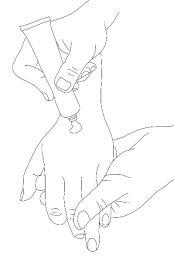
- Despegue a camada de papel do penso oclusivo.
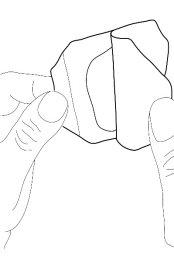
- Remova as coberturas do penso oclusivo e, em seguida, coloque-o com cuidado sobre o montículo de creme. Não estenda o creme coberto pelo penso.
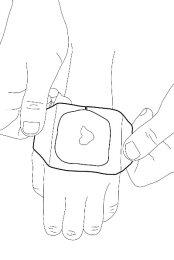
- Remova a camada de plástico. Alise os bordos do penso oclusivo com cuidado. Em seguida, deixe-o no lugar por pelo menos 60 minutos, se a pele não estiver danificada. O creme não deve ser deixado no lugar por mais de 60 minutos em crianças menores de 3 meses ou por mais de 30 minutos em crianças com uma afecção que produz coceira na pele, denominada “dermatite atópica”. Se o creme for utilizado nos genitais ou sobre úlceras, os tempos de aplicação podem ser mais curtos, como descrito a seguir.
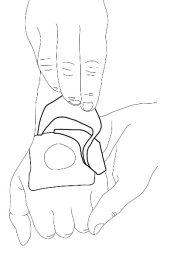
- O médico ou enfermeiro removerá o penso oclusivo e limpará o creme antes de iniciar a intervenção (por exemplo, justo antes de inserir a agulha).
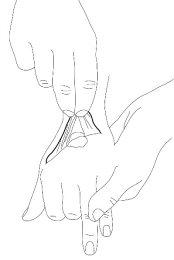
Uso em áreas mais extensas de pele recém-rasurada antes de intervenções ambulatoriais (como as técnicas de depilação a laser)
Siga as instruções do seu profissional de saúde.
A dose recomendada é de 1 g de creme por cada 10 cm2 (10 centímetros quadrados) de extensão, aplicada de 1 a 5 horas sob um penso oclusivo. Anamap não deve ser utilizado em áreas recém-rasuradas de mais de 600 cm2 (600 centímetros quadrados, por exemplo, 30 cm x 20 cm) de extensão. A dose máxima é de 60 g.
Antes de intervenções hospitalares (como enxertos de pele) que requerem uma anestesia mais profunda
- Anamap pode ser utilizado desta forma em adultos e adolescentes com mais de 12 anos, mas apenas sob a supervisão de um médico ou enfermeiro.
- A dose recomendada é de 1,5 g a 2 g de creme por cada 10 cm2 (10 centímetros quadrados) de extensão.
- Depois de aplicar o creme, cubra com um penso oclusivo durante um tempo mínimo de 2 horas e máximo de 5 horas.
Uso sobre a pele para eliminar lesões verrugosas denominadas “molusco”
- Anamap pode ser utilizado em crianças e adolescentes que padecem de uma afecção cutânea denominada “dermatite atópica”.
- A dose habitual depende da idade da criança e é utilizada durante 30 a 60 minutos (30 minutos se o paciente tiver dermatite atópica). O seu médico, enfermeiro ou farmacêutico indicará quanto creme deve ser aplicado.
Uso na pele dos genitais antes da injeção de anestesia local
- Anamap pode ser utilizado desta forma apenas em adultos e adolescentes com mais de 12 anos e apenas aplicado por um profissional de saúde.
- A dose recomendada é de 1 g de creme (1g a 2g para pele genital feminina) por cada área de pele de 10 cm2 (10 centímetros quadrados) de extensão.
- O creme é aplicado sob um vendagem oclusivo. Este é mantido durante 15 minutos na pele dos genitais masculinos e durante 60 minutos na pele dos genitais femininos.
Uso nos genitais antes de cirurgia cutânea menor (como a extirpação de verrugas)
Anamap pode ser utilizado desta forma apenas em adultos e adolescentes com mais de 12 anos e apenas aplicado por um profissional de saúde.
A dose recomendada é de 5 g a 10 g de creme durante 10 minutos. Sem penso oclusivo. A intervenção médica deve começar imediatamente.
Uso antes da limpeza ou desbridamento de úlceras de pernas
- Anamap pode ser utilizado desta forma em adultos, mas apenas sob a supervisão de um médico ou enfermeiro.
- A dose recomendada é de 1 g a 2 g de creme por cada 10 cm2 até um máximo de 10 g.
- O creme é aplicado sob um vendagem oclusivo, por exemplo, uma envoltura de plástico. Este é mantido de 30 a 60 minutos antes de limpar a úlcera. Elimine o creme com uma gaze de algodão e comece a limpeza sem demora.
- Anamap pode ser utilizado antes de limpar as úlceras de pernas até um máximo de 15 vezes durante um período de 1 a 2 meses.
- O tubo de Anamap é para um único uso quando utilizado sobre úlceras de pernas: o tubo com qualquer conteúdo restante deve ser descartado cada vez após tratar um paciente.
Se utilizar mais Anamap do que o indicado:
Se utilizar mais Anamap do que o descrito neste prospecto ou mais do que o indicado pelo seu médico, farmacêutico ou enfermeiro, entre em contato com eles imediatamente, mesmo que não apresente nenhum sintoma.
Os sintomas produzidos por usar demasiada quantidade de Anamap são os seguintes. A aparência desses sintomas é muito improvável se Anamap for utilizado como recomendado.
- Sensação de tontura ou aturdimento.
- Formigamento da pele que rodeia a boca e adormecimento da língua.
- Gosto anormal.
- Visão borrada.
- Zumbido nos ouvidos.
- Também existe o risco de metahemoglobinemia aguda (um problema dos níveis de pigmentação do sangue). É um problema mais frequente quando se estão tomando determinados medicamentos. Nesses casos, a pele se torna de cor azul-acinzentada devido à falta de oxigênio.
Nos casos graves de sobredosagem, os sintomas podem incluir convulsões, tensão arterial baixa, respiração lenta, cese da respiração e alterações do pulso. Esses efeitos podem ser potencialmente mortais.
Se tiver alguma dúvida sobre o uso deste medicamento, consulte o seu médico, farmacêutico ou enfermeiro.
4. Efeitos adversos possíveis
Tal como todos os medicamentos, este medicamento pode provocar efeitos adversos, embora nem todas as pessoas os sofram.
Entre em contacto com o seu médico ou farmacêutico se algum dos seguintes efeitos adversos o incomodar ou não parecer desaparecer. Informe o seu médico de qualquer outra coisa que o faça sentir mal enquanto utilizar Anamap.
Pode aparecer uma ligeira reação (paletez ou rubor da pele, ligeira tumefação, ardor ou picazón inicial) na zona sobre a qual se aplica Anamap. Trata-se de reações normais à pomada e aos anestésicos e desaparecerá em pouco tempo sem necessidade de tomar qualquer medida.
Se experimentar algum efeito desagradável ou incomum enquanto utiliza Anamap, deixe de o utilizar e consulte o seu médico ou farmacêutico o mais breve possível.
Frequentes(podem afetar 1 em cada 10 pessoas):
- Reações na pele locais transitórias (paletez, rubor, tumefação) na zona de aplicação durante o tratamento na pele, na mucosa genital ou nas úlceras nas pernas
- Uma ligeira sensação inicial de ardor, picazón ou calor na zona de aplicação durante o tratamento na mucosa genital ou nas úlceras nas pernas.
Pouco frequentes(podem afetar 1 em cada 100 pessoas):
- Uma ligeira sensação inicial de ardor, picazón ou calor na zona tratada durante o tratamento na pele.
- Adormecimento (formigamento) na zona de aplicação durante o tratamento na mucosa genital.
- Irritação da pele na zona de aplicação durante o tratamento das úlceras nas pernas.
Raros(podem afetar 1 em cada 1000 pessoas):
- Reações alérgicas que, em casos raros, podem chegar a ser um choque anafiláctico (erupção cutânea, tumefação, febre, dificuldade respiratória e desmaio) durante o tratamento na pele, na mucosa genital ou nas úlceras nas pernas.
- Metahemoglobinemia (distúrbio do sangue) durante o tratamento da pele.
- Pequena hemorragia ponteada na área tratada (particularmente em crianças com eczema após longos períodos de aplicação) durante o tratamento da pele.
- Irritação dos olhos se Anamap entrar acidentalmente em contacto com os olhos durante o tratamento da pele.
Outros efeitos adversos em crianças
Metahemoglobinemia, um distúrbio do sangue que se costuma observar com maior frequência em recém-nascidos e lactentes de 0 a 12 meses, frequentemente associado a sobredosagem.
Comunicação de efeitos adversos
Se experimentar qualquer tipo de efeito adverso, consulte o seu médico, farmacêutico ou enfermeiro, mesmo que se trate de possíveis efeitos adversos que não aparecem neste prospecto. Também pode comunicá-los diretamente através do Sistema Espanhol de Farmacovigilância de medicamentos de Uso Humano: https://www.notificaram.es. Mediante a comunicação de efeitos adversos, você pode contribuir para proporcionar mais informações sobre a segurança deste medicamento.
5. Conservação de Anamap
Conservar a menos de 30°C, não refrigerar nem congelar.
Utilizar em 6 meses desde a primeira abertura.
Mantenha este medicamento fora da vista e do alcance das crianças.
Não utilize este medicamento após a data de caducidade indicada no envase após CAD. A data de caducidade é o último dia do mês que se indica.
Os medicamentos não devem ser jogados nos deságues nem na lixeira. Deposite os envases e os medicamentos que não precisa no ponto SIGRE da farmácia. Em caso de dúvida, pergunte ao seu farmacêutico como se livrar dos envases e dos medicamentos que não precisa. Dessa forma, você ajudará a proteger o meio ambiente.
6. Conteúdo do envase e informações adicionais
Composição de Anamap
- Os princípios ativos são lidocaína e prilocaína. Cada grama de pomada contém 25 mg de lidocaína e 25 mg de prilocaína.
- Os demais componentes são hidroxiestearato de macroglicerol (óleo de rícino hidrogenado polioxil), carbómero (974P), hidróxido de sódio e água purificada.
Aspecto do produto e conteúdo do envase
Anamap é uma pomada branca macia. Apresenta-se em um tubo de alumínio plegável de 5 g e 30 g, coberto internamente com uma laca epoxifenólica.
Tamanho dos envases:
1 x tubo de 30 g
1 x tubo de 5 g
1 x tubo de 5 g com 2 apósitos
1 x tubo de 5 g com 3 apósitos
5 x tubo de 5 g
5 x tubo de 5 g com 12 apósitos
Pode ser que nem todos os tamanhos de envases sejam comercializados.
Titular da autorização de comercialização e responsável pela fabricação
Titular da autorização de comercialização:
Glenmark Arzneimittel GmbH
Industriestr. 31
82194 Gröbenzell
Alemanha
Responsável pela fabricação:
Rafarm SA
Thesi Pousi-Xatzi
Agiou Louka
Paiania, Attiki-19002
P.P. Box 37
Grécia
Qualimetrix SA
579 Mesogeion avenue, Agia Paraskevi
Atenas, 15343
Grécia
Podem solicitar mais informações sobre este medicamento dirigindo-se ao representante local do titular da autorização de comercialização:
Glenmark Farmacêutica, S.L.U.
C/ Retama 7, 7ª planta
28045 Madrid
Espanha
Este medicamento está autorizado nos estados membros do Espaço Económico Europeu com os seguintes nomes:
Dinamarca: Nulbia
Bulgária: ROMLA 25mg/25mg/g ????
Alemanha: Emulus® 25mg/g + 25mg/g Creme
Polônia: MOTTI
Romênia: ROMLA 25mg/25mg/g Crema
Suécia: Lidokain/Prilokain Alternova
Reino Unido: Nulbia 5% Cream
Espanha: Anamap 25mg/g + 25mg/g crema
República Checa: ROMLA
Eslováquia: ROMLA
Data da última revisão deste prospecto:Abril 2021
A informação detalhada deste medicamento está disponível na página web da Agência Espanhola de Medicamentos e Produtos Sanitários (AEMPS) http://www.aemps.gob.es/.

Quanto custa o ANAMAP 25 mg/g + 25 mg/g CREME em Espanha em 2025?
O preço médio do ANAMAP 25 mg/g + 25 mg/g CREME em dezembro de 2025 é de cerca de 10.02 EUR. Os valores podem variar consoante a região, a farmácia e a necessidade de receita. Confirme sempre com uma farmácia local ou fonte online para obter informações atualizadas.
- País de registo
- Preço médio em farmácia10.02 EUR
- Substância ativa
- Requer receita médicaSim
- Fabricante
- Esta informação é apenas para referência e não constitui aconselhamento médico. Consulte sempre um médico antes de tomar qualquer medicamento. A Oladoctor não se responsabiliza por decisões médicas baseadas neste conteúdo.
- Alternativas a ANAMAP 25 mg/g + 25 mg/g CREMEForma farmacêutica: CREME, 25 mg/g + 25 mg/gSubstância ativa: combinationsFabricante: Galenicum Derma S.L.U.Requer receita médicaForma farmacêutica: CREME, Lidocaína 25 mg/g + Prilocaína 25 mg/gSubstância ativa: combinationsFabricante: Mesoestetic Pharma Group S.L.Requer receita médicaForma farmacêutica: CREME, 25 mg de lidocaína; 25 mg de prilocaína/ gSubstância ativa: combinationsFabricante: Aspen Pharma Trading LimitedRequer receita médica
Alternativas a ANAMAP 25 mg/g + 25 mg/g CREME noutros países
As melhores alternativas com o mesmo princípio ativo e efeito terapêutico.
Alternativa a ANAMAP 25 mg/g + 25 mg/g CREME em Polónia
Alternativa a ANAMAP 25 mg/g + 25 mg/g CREME em Ukraine
Médicos online para ANAMAP 25 mg/g + 25 mg/g CREME
Avaliação de posologia, efeitos secundários, interações, contraindicações e renovação da receita de ANAMAP 25 mg/g + 25 mg/g CREME – sujeita a avaliação médica e regras locais.














